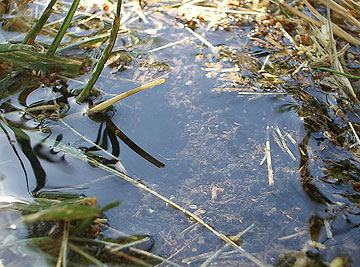- Home
- Learn about salinity
- Get to know your site
- Design a landscape
- Solve a problem
- Other information
Salinity Management Guide

Assessing the movement of water through soil
For a landscape irrigated with water of elevated salinity, it's particularly important to determine the rate at which water moves through the soil. If water doesn't move readily, the soil may become saturated with water and salts may eventually become concentrated near the surface of the soil, possibly injuring plants. In such a situation, compensatory management practices may be needed. Without them, the soil will become gradually more saline, leading to additional problems.
Several basic aspects of water's movement through soil are of particular interest when describing and characterizing a landscape's salinity:
- Rate of infiltration
The rate of infiltration of water into the soil's surface determines how much water enters the soil and is available to plants. In a saline environment, the rate of infiltration largely determines whether salt present in the soil will get leached down past the roots of plants or instead accumulate near the roots. Numerous methods are available for measuring the rate of infiltration.
- Rate of percolation
The rate of water's percolation through the subsoil ranges widely. It can be as slow as one-tenth millimeter per hour. Soil with that sort of rate is virtually impervious, so the leaching of salts is essentially impossible. The rate of percolation also can be as high as 250 millimeters per hour, or a bit more. Such high rates often mean less water is available to plants. A moderate percolation rate, such as 25 to 100 millimeters per hour, is optimal. It provides sufficient transfer of water and of the many solutes that serve as nutrients for plants. It also permits adequate aeration of the soil and allows for water-holding relations that are sufficient to sustain plants between irrigations. Various methods are available for estimating the rate of percolation.
- Rate of subsurface drainage
For a site irrigated with recycled water or some other source of water that's somewhat elevated in salinity, providing drainage is an essential prerequisite if the project is to have a life of many years. Subsurface drainage, or field drainage, is defined as the removal from a site's soil or subsoil of the excess water that might otherwise restrict or impair the growth of landscape plants. Various methods are available for estimating the rate of subsurface drainage.
| « Previous page | Next page » |